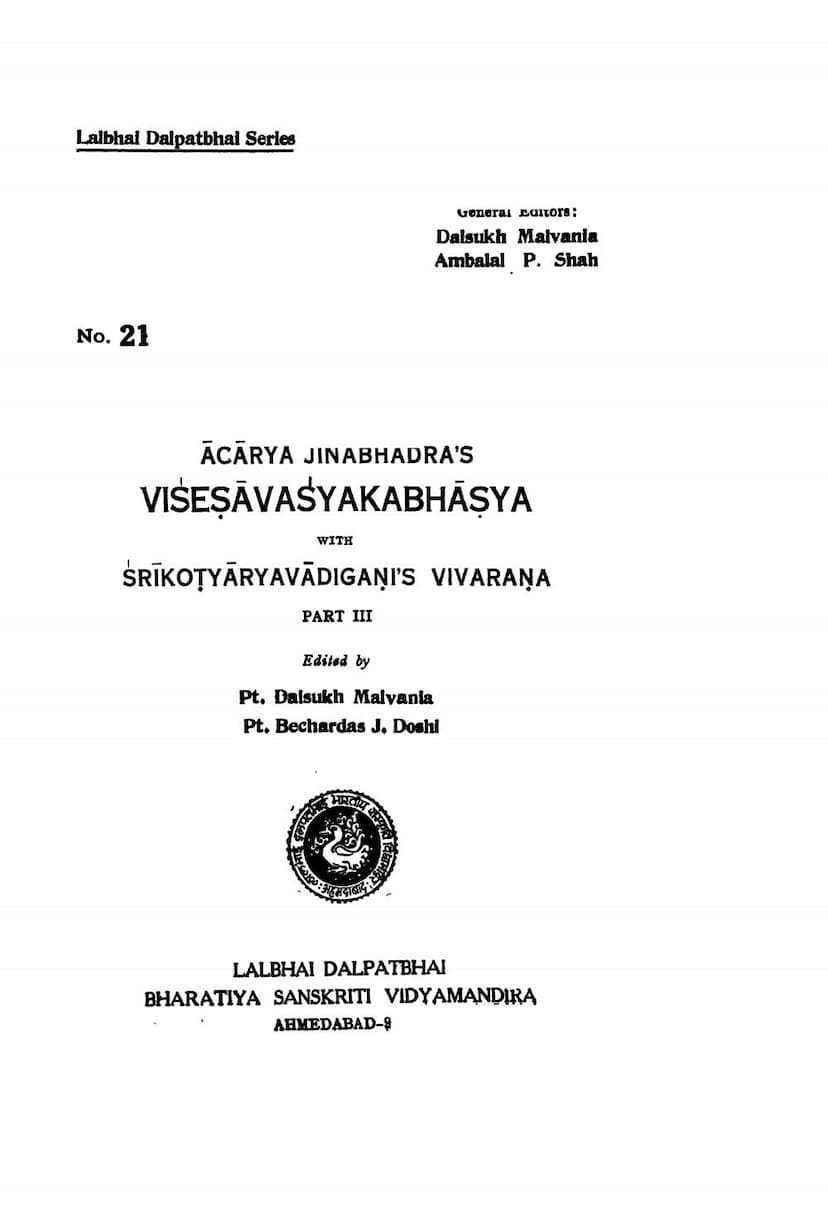Visesavasyakabhasya Part 3
Added to library: September 2, 2025

Summary
This is a comprehensive summary of "Visesavasyakabhasya Part 3" by Acarya Jinabhadra Suri, with the commentary "Kotyarvadyagani's Vivarana," edited by Pt. Dalsukh Malvania and Pt. Bechardas J. Doshi, and published by L. D. Indology, Ahmedabad.
This volume, Part III of Acarya Jinabhadra Suri's Visesavasyakabhasya, along with the Sanskrit commentary by Sri Kotyarvadyagani, completes the entire text with its auto-commentary and the supplementary commentary. The Visesavasyakabhasya is presented as a highly important Jain philosophical text, offering insights into the methodology of Jain commentarial literature and a thorough discussion of Jain epistemology. The text includes elucidations and explanations through dialogues, particularly those of Lord Mahavira with Ganadharas and Nihnavas.
Key aspects highlighted in the introduction and the text:
- Title of the Work: While Ac. Jinabhadra himself refers to his work as "Atasayāņuyoga" (Avaśyakanuyoga), it is commonly known as "Višeşavasyakabhasya." The term "Bhāṣya" signifies a commentary on the Avaśyakaniryukti, possibly differentiating it from an older, existing bhāṣya. The "Viśeşa" likely points to its commentary on the Sāmāyika-adhyayana, the first chapter of the Āvaśyaka-sūtra.
- Focus on Sāmāyika: The Visesavasyakabhasya, like the Anuyogadvārasūtra, demonstrates a method of commenting on Āgamas by first explaining the 'entrances' to exposition and then commenting on the Sāmāyika-adhyayana. Jinabhadra argues that Sāmāyika, representing equanimity, is the basis of all spiritual qualities and can encompass all other chapters, thus making its commentary foundational.
- Antiquity of Sāmāyika: There's evidence suggesting that Sāmāyika might have been an independent work in ancient times, predating its inclusion as a chapter in the Avaśyakasūtra. Its presence in the curriculum of monks and its mention in the Titthogaliya point to its long-standing importance.
- Authorship and Time Period: Acarya Jinabhadra Kṣamāśramaṇa is identified as the author, likely belonging to the 7th century V.S. (circa 609 A.D.). His work served as a crucial lamp for subsequent commentators like Jinadasa, Haribhadra, and Abhayadeva. He is credited with being well-versed in Āgamas and contemporary Indian philosophical systems.
- Commentarial Literature: The volume includes the auto-commentary by Ac. Jinabhadra, which he left incomplete after gātha no. 2318 due to his passing. Kottaryavadi completed it, and this supplement is also published. Other commentaries by Kotyācārya and Ac. Maladhari Hemacandra are mentioned as having been published previously, with Hemacandra's commentary (1175 V.S. / 1118 A.D.) being considered the best.
- Methodology: The text follows the expositional order of the Anuyogadvārasūtra, discussing topics like the five Jñānas (Mati, Śruta, Avadhi, Manahparyāya, Kevala), the meaning of the title "Avaśyaka-śruta-skandha" through the method of nikṣepa, and then delving into specific chapters.
- Key Topics Covered:
- Jñāna: Exposition of the five Jñānas, with Jinabhadra's view serving as a model for later Acāryas.
- Samudayārtha/Piṇḍārtha: Explanation of the title and the overall subject matter of the Avaśyaka-sūtra.
- Avayavārtha: Detailed exposition of chapters, beginning with Sāmāyika.
- Four Entrances to Exposition: Upakrama, Nikṣepa, Anugama, and Naya, with a special focus on the Anugama's length and the inclusion of Naya within it.
- Upoḍghāta: The preface or introduction, covering points like Uddeśa, Nirdeśa, and Nirgamadvāra. This section discusses the nature of a Tirthankara, the life of Lord Mahavira, the synthesis of knowledge and action for liberation, and the origin of Śruta through Tirthankaras and Ganadharas.
- Nihnavavāda: An extensive discussion on seven (or eight, including Botika) Nihnavas (schismatics), which has become an independent treatise.
- Nayas: An in-depth exploration of all seven Nayas (ways of approach), highlighting their synthesis in Syadvada and the potential for misinterpretation if not applied correctly.
- Anumatadvāra and Samāvatāradvāra: Discussion on which Sāmāyika leads to liberation according to different nayas and the historical separation of the four Anuyogas.
- Kim-dvāra: Examining the nature of Sāmāyika from a categorical perspective (soul or non-soul, substance or quality).
- Bheda-dvāra: Discussing the divisions of Sāmāyika (Sammyaktva, Sruta, Caritra) and their subdivisions.
- Kena-dvāra: Investigating who possesses Sāmāyika, focusing on self-control, austerities, and equanimity towards all souls.
- Kva-dvāra: Where Sāmāyika takes place.
- Kesu-dvāra: To whom Sāmāyika is related.
- Katham-dvāra: How it is acquired.
- Kiyacciraṁ-dvāra: How long it continues.
- Kati-dvāra: How many people can acquire it.
- Antara-dvāra: The time required for reattainment.
- Aviraha-dvāra: The time mundane souls remain without Sāmāyika.
- Bhava-dvāra: For how many lives it can be retained.
- Ākarsha-dvāra: How many times it should be performed.
- Sparśana-dvāra: Space points touched by a soul with Sāmāyika.
- Nirukti-dvāra: Etymological explanation of "Sāmāyika," emphasizing freedom from attachment and aversion.
- Pancanmaskāra: A detailed exposition of the Pancanmaskāra, treated as an independent treatise.
- Sāmāyika-nirukti: Explanation of each pada of the Sāmāyika text.
- Philosophical Synthesis: Jinabhadra's work demonstrates his scholarship in synthesizing Jain philosophy with other Indian philosophical currents of his time, presenting Jain philosophy as a synthesis of various viewpoints (nayas).
- Authorship of Avaśyakasūtra: The text discusses the traditional view of Tirthankara as the author of the meaning and Ganadharas as the authors of the words, alongside the view that Avaśyaka, being Angabahya, is by a Sthavira.
- Authorship of Avaśyakaniryukti: Identified as the oldest commentary on the Avaśyakasūtra, attributed to Bhadrabahu (Junior), distinct from the Senior Bhadrabahu.
- Jinabhadra's Tour: Evidence from inscriptions suggests Jinabhadra toured regions from Mathura to Valabhi in Western India.
- Works of Jinabhadra: Besides Visesavasyakabhasya, he is believed to have authored Brhatsangrahani, Brhatksetrasama, Visesaṇavati, Jitakalpasūtra, and Bhagya.
Financial Assistance: The publication of this volume was supported by a grant-in-aid from the Ministry of Education, Government of India.
This third part is crucial as it aims to provide the complete text, including the auto-commentary and the crucial supplementary commentary by Kotyaryavadi, making it a significant contribution to the study of Jain philosophy.